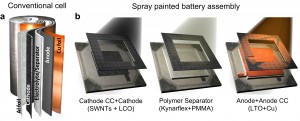Spray-on battery, 3D printing
 Rice University demos a process to spray-on batteries. This is Another step towards fully automated fabrication.
Rice University demos a process to spray-on batteries. This is Another step towards fully automated fabrication.
It was easy to predict that 3D printing would be able to make electronic parts. The process Rice uses probably doesn’t actually need 3D printing to work but it fits the concept. Multiple layers of different materials are sprayed on a surface to create a battery.
Circuits are already being made using normal 2D printers by varying the thickness of the traces to create resistors and conductors. By using a 2 or 3 different materials the full range of electronic parts could be printed directly into the circuit so a robot could literally print a copy of itself. Stratasys and Optomec have already printed electronics.
The spray-on battery will make it easier to build batteries of different shapes and sizes. It will also make it possible for nearly anyone to make batteries anywhere in the world. This can drastically reduce the real costs in terms of time and materials.
1 million views on my Youtube Channel
 My Youtube channel, just surpassed 1 million video views.
My Youtube channel, just surpassed 1 million video views.
I posted my first video Why 88% of Ideas Fail to Make it to Market on February 11, 2008. Since then I’ve posted a total of 30 videos but by far the video with the most views was Why We Don’t Have Flying Cars, Yet.
My channel is now receiving over 100,000 views per month so the second million views should happen in less than a year. To celebrate 1 million views and to help get more views I’m making Predictive Innovation Core Skills: Inversion available for free.
Zero Mines, cheap-low-tech land mine clearing tool
Zero Mines is a group of people worldwide working on Open Source solutions for clearing land mines so people can grow food, travel, and live safely. Here is my suggestion.

Over 100 million land mines have been deployed around the world. Most of the places where these land mine are located are impoverished. The area that needs to be cleared is vast. The ideal solution would use cheap, easily available materials, that can be put together by anyone so that local people can quickly clear their own land.
The standard military approach to clearing a mine field is to use a heavily armored vehicle with a motorized flail to trigger the landmines. Armor is one way of staying safe while detonating a mine but not the only way. Distance is another.
A strong rope is cheap and can pull a heavy object across a mine field from a distance to detonate any mines. But you typically must go forward into a mine field. So how can you pull something towards you without first putting it in front of you? There is a very simple way.
The device I described fits those requirements. It is just a big rake rotating on a pivot pulled by a rope or cable from a safe distance to trigger mines.
1. place the pivot
2. pull the rope or cable from a safe distance or behind sand bags
3. sweep the rake over area to be cleared
4. move pivot / rake to cover more area
5. repeat
Dragging an object a distance from the arm would reduce the damage to the arm but even if the arm is damaged it is cheap and easy to replace. This might not be enough for all uses of the land or all types of land but can quickly clear an area for human travel and light use. If you need to go deeper use a heavier object and tines to dig up the ground.



 Predictive Innovation Training
Predictive Innovation Training Predictive Innovation: Core Skills Book
Predictive Innovation: Core Skills Book RoundSquareTriangle.com
RoundSquareTriangle.com